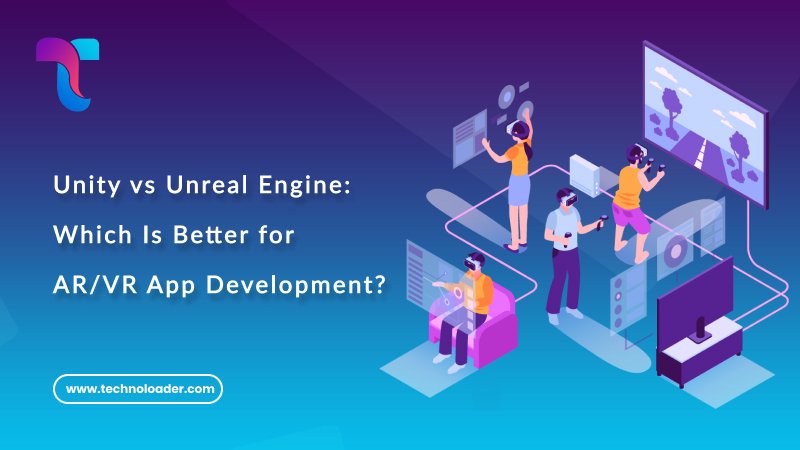In the fast-paced world of immersive technology, choosing the right engine is crucial for developing successful AR/VR apps. Two names that always come up in this discussion are Unity and Unreal Engine. Both of these engines are packed with powerful tools, but they serve different purposes and skill levels. So, which one should you choose for AR/VR app development in 2025—Unity or Unreal Engine? Let’s dive into a detailed comparison to help you make the best choice.
Unity for AR/VR App Development
Unity has long been a favorite among developers in the AR/VR space due to its flexibility and user-friendly interface. It is especially popular among indie developers and startups.
Key benefits of Unity:
Cross-platform compatibility:
Unity supports multiple platforms including Android, iOS, Oculus, HTC Vive, PlayStation VR, Magic Leap, and HoloLens. This makes it a great engine for developers looking to deploy on multiple devices.
Robust community and asset store:
Unity has a huge developer community and a powerful asset store full of ready-to-use 3D models, scripts, and plugins, making AR/VR development much faster.
Lightweight performance:
Unity’s runtime is optimized for mobile and lightweight hardware, making it ideal for AR applications on smartphones and wearable AR devices like AR glasses.
C# programming language:
Unity uses C#, which is easy for beginners to use and widely supported, lowering the entry barrier for new AR/VR developers.
AR Foundation framework:
Unity’s AR Foundation allows developers to create cross-platform AR experiences using the same codebase, supporting both ARKit (iOS) and ARCore (Android).
Disadvantages of Unity:
- Visual fidelity is not as high as Unreal’s.
- Real-time lighting and shaders require more optimization to match Unreal’s cinematic quality.
Unreal Engine for AR/VR App Development
Here’s the text we’re looking at: The Unreal Engine, built by Epic Games, is renowned for its breathtaking visuals and real-time photorealistic rendering, making it a top choice for high-end VR experiences.
Key benefits of the Unreal Engine:
Superb graphics and rendering:
The Unreal Engine uses the impressive Lumen system for real-time global illumination and Nanite for virtualized geometry, making it perfect for ultra-realistic VR simulations and architectural visualization.
Blueprint visual scripting:
With Unreal’s Blueprint system, developers can prototype or create entire experiences without writing any code, which is a huge benefit for designers and artists working in AR/VR development.
High-performance VR:
Unreal offers great support for high-end VR devices used in gaming and enterprise training simulations thanks to its robust rendering pipeline.
Full access to the source code:
Developers have the ability to modify Unreal’s core engine for optimal performance – an important feature for complex or resource-heavy AR/VR applications.
Disadvantages of Unreal Engine:
- It has a steep learning curve, especially for developers who aren’t familiar with C++.
- The heavy runtime makes it less ideal for lightweight AR devices or mobile AR applications.
- Its asset store is smaller than Unity.
Unity vs Unreal Engine: Feature Comparison for AR/VR
| Feature | Unity | Unreal Engine |
|---|---|---|
| Graphics Quality | Good (customizable) | Excellent (photorealistic) |
| Ease of Use | Beginner-friendly | Steeper learning curve |
| Programming Language | C# | C++ and Blueprints |
| Platform Support | Extensive mobile & AR glasses | Best for high-end VR hardware |
| Community & Assets | Massive community + asset store | Smaller asset store but quality docs |
| Performance on Mobile AR | Optimized for low-spec devices | Less optimal for mobile |
| Enterprise VR Simulations | Moderate | Excellent |
Conclusion: Which Is Better for AR/VR Development?
When it comes to deciding between Unity and Unreal Engine for AR/VR app development, it really depends on what you want to achieve with your project:
- If you’re focused on mobile AR apps, creating cross-platform experiences, or if you’re just starting out in the world of immersive development, choose Unity. Its flexibility, wide hardware compatibility, and user-friendly interface make it a great choice for quick prototyping and lightweight AR applications.
- On the other hand, if you’re looking for spectacular, cinematic visuals, working on high-end VR training simulations, or if you want full control over rendering performance, choose Unreal Engine. Unreal really excels at enterprise VR, architecture, and games that require a high level of realism.
Final Thoughts
Both Unity and Unreal Engine are fantastic tools for AR/VR development. Unity shines with its scalability and user-friendly approach, making it a great choice for both commercial and indie projects. On the other hand, Unreal Engine requires a bit more expertise but delivers stunning visual quality for truly immersive experiences.
If you’re eager to create innovative AR/VR applications that blend technology with creativity, teaming up with a professional AR/VR development company like Technoloader can really elevate your project. With their extensive knowledge of both Unity and Unreal Engine, Technoloader assists businesses in crafting memorable experiences that stand out in today’s competitive digital world.
Ready to dive in? Choose your engine wisely—or let Technoloader steer you through your AR/VR adventure with the right tools, talent, and technology.
Related Reads
- Custom Fitness App Development: Build the Fitness App Your Users Actually Want
- How to Book the Best Tent in Kutch for the Rann Utsav Season
- Expert Tips: Choosing Between Smart Glass and Smart Film for Your Project
- Lace Bra Panty Lingerie Set – Elegance Redefined by Sheluxe
- Top Leather And Fur Jacket Ideas to Style at Any Event
- Essential Steps for Creating Effective Corporate Training



